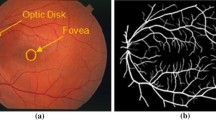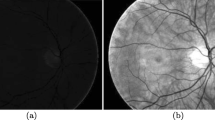Abstract
An automated method for blood vessel segmentation is presented in this paper. The approach uses the nonlinear orthogonal projection to capture the features of vessel networks, and derives a novel local adaptive thresholding algorithm for vessel detection. By embedding in a kind of image decomposition model, the selection of system parameter which reflects the size of concerned convex set is examined. This approach differs from previously known methods in that it uses matched filtering, vessel tracking or supervised methods. The algorithm was tested on two publicly available databases: the DRIVE and the STARE. By comparison with hand-labeled ground truth, an average accuracy of 96.1% is achieved on the former database, and an average accuracy of 90.8% is achieved on the later database.








Similar content being viewed by others
References
Kahai, P., Namuduri, K. R., & Thompson, H. (2006). A decision support framework for automated screening of diabetic retinopathy. Inernational Journal of Biomedical Imaging, 1–8.
Cornforth, D. J., Jelinek, H. J., Leandro, J. J. G., Soares, J. V. B., Cesar, R. M. Jr., et al. (2004). Development of retinal blood vessel segmentation methodology using wavelet transforms assessment of diabetic retinopathy, The 8th Asia Pacific Symposium on Intelligent and Evolutionary Systems, 50–60.
Li, H., Hsu, W., Lee, M. L., & Wang, H. (2005). Automatic grading of retinal vessel calibre. IEEE Transactions on Biomedical Engineering, 52(7), 1352–1355.
Broadway, D. C., Drance, S. M., Parfitt, C. M., & Mikelberg, F. S. (1998). The ability of scanning laser ophthalmoscopy to identify various glaucomatous optic disk appearances. American journal of ophthalmology, 125(5), 593–604.
Miglior, S., Guareschi, M., Albe', E., Gomarasca, S., Vavassori, M., & Orzalesi, N. (2003). Detection of glaucomatous visual field changes using the moorfields regression analysis of the Heidelberg retina tomograph. American Journal of Ophthalmology, 136(1), 26–33.
Vongphanit, J., Michell, P., & Wang, J. J. (2002). Population prevalence of titled optic disks and the relationship of this sign to refractive error. American Journal of Ophthalmology, 133(5), 679–685.
Vongphanit, J., Michell, P., & Wang, J. J. (2002). Prevalence and progression of myopic retinopathy in an older population. Ophthalmology, 109, 704–711.
Hoover, A., Kouznetsova, V., & Goldbaum, M. (2000). Locating blood vessels in retinal images by piecewise threshold probing of a matched filter response. IEEE Transactions on Medical Imaging, 19, 203–210 March.
Chaudhuri, S., Chatterjee, S., Katz, N., Nelson, M., & Goldbaum, M. (1989). Detection of blood vessels in retinal images using two-dimensional matched filters. IEEE Transactions on Medical Imaging, 8(3), 263–269.
Martínez-Pérez, M. E., Hughes, A. D., Stanton, A. V., Thom, S. A., Bharath, A. A., & Parker, K. H. (1999). Retinal blood vessel segmentation by means of scale-space analysis and region growing. In Medical Image Computing and Computer-assisted Intervention—MICCAI, 90–97.
Gang, L., Chutatape, O., & Krishnan, S. M. (2002). Detection and measurement of retinal vessels in fundus images using amplitude modified second-order Gaussian filter. IEEE Transactions on Biomedical Engineering, 49(2), 168–172.
Jiang, X., & Mojon, D. (2003). Adaptive local thresholding by verification-based multithreshold probing with application to vessel detection in retinal images. IEEE Transactions on Pattern Analysis and Machine Intelligence, 25(1), 131–137.
Soares, J. V. B., Leandro, J. J. G., Cesar Jr., R. M., Jelinek, H. F., & Cree, M. J. (2006). Retinal vessel segmentation using the 2-D Gabor wavelet and supervised classification. IEEE Transactions on Medical Imaging, 25, 1214–1222.
Zana, F., & Klein, J. -C. (2001). Segmentation of vessel-like patterns using mathematical morphology and curvature evaluation. IEEE Transactions on Medical Imaging, 11(7), 1111–1119.
Mendonca, A. M., & Campilho, A. (2006). Segmentation of retinal blood vessels by combining the detection of centrelines and morphological reconstruction. IEEE Transactions On Medical Imaging, 25(9), 1200–1213.
Can, A., Shen, H., Turner, J. N., Tanenbaum, H. L., & Roysam, B. (1999). Rapid automated tracing and feature extraction from retinal fundus images using direct exploratory algorithms. IEEE Transactions on Information Technology in Biomedicine, 3(2), 125–138.
Tolias, Y. A., & Panas, S. M. (1998). A fuzzy vessel tracking algorithm for retinal images based on fuzzy clustering. IEEE Transactions on Medical Imaging, 17(2), 263–273.
Chutatape, O., Zheng, L., & Krishnan, S. M. (1998). Retinal blood vessel detection and tracking by matched Gaussian and Kalman filters. In Proc. of the 20th Annual International Conference of the IEEE Engineering in Medicine and Biology Society (EMBS'98), 20, 3144–3149.
Gao, X., Bharath, A., Stanton, A., Hughes, A., Chapman, N., & Thom, S. (2001). A method of vessel tracking for vessel diameter measurement on retinal images. In ICIP01, II, 881–884.
Sinthanayothin, C., Boyce, J., & Williamson, C. T. (1999). Automated localisation of the optic disc, fovea, and retinal blood vessels from digital colour fundus images. British Journal of Ophthalmology, 83, 902–910.
Staal, J. J., Abramoff, M. D., Niemeijer, M., Viergever, M. A., & van Ginneken, B. (2004). Ridge based vessel segmentation in color images of the retina. IEEE Transactions on Medical Imaging, 23(4), 501–509.
Rudin, L., Osher, S., & Fatemi, E. (1992). Nonlinear total variation based noise removal algorithms. Physica D, 60, 259–268.
Vese, L., & Osher, S. (2003). Modeling textures with total variation minimization and oscillating patterns in image processing. Journal Scientific Computing, 9, 553–572.
Chambolle, A. (2004). “An algorithm for total variation minimization and applications. Journal Mathematical Imaging and Vision, 20, 89–97.
Aujol, J. F., Aubert, G., Blanc-Féraud, L., & Chambolle, A. (2005). Image decomposition into a bounded variation component and an oscillating component. Journal of Mathematical Imaging and Vision, 22(1), 71–88.
Meyer, Y. (2001). Oscillating patterns in image processing and in some nonlinear evolution equations. The Fifteenth Dean Jacqueline B. Lewis Memorial Lectures. AMS:Boston MA, USA.
Strong, D., & Chan, T. (2003). Edge-preserving and scale-dependent properties of total variation regularization. Inverse Problems, 19(6), 165–187.
Strong, D., Aujol, J.-F., & Chan, T. (2006). Scale recognition, regularization parameter selection, and Meyer's G norm in total variation regularization. SIAM Journal on Multiscale Modeling and Simulation, 5(1), 273–303.
Aujol, J. F., Gilboa, G., Chan, T., & Osher, S. (2006). Structure-texture image decomposition—Modeling, algorithms, and parameter selection. International Journal of Computer Vision, 67(1), 111–136.
Gilboa, G., Sochen, N., & Zeevi, Y. Y. (2006). Estimation of optimal PDE-based denoising in the SNR sense. IEEE Transactions on Image Processing, 15(8), 2269–2280.
Aujol, J.-F., & Chambolle, A. (2005). Dual norms and image decomposition models. International Journal of Computer Vision, 63(1), 85–104.
Tong, C. S., Zhang, Y., & Zheng, N. (2005). Variational image binarization and its multiscale realizations. Journal of Mathematical Imaging and Vision, 23, 185–198.
Acknowledgements
The authors would like to thank the anonymous reviewers for their comments and suggestions which have greatly improved the presentation of this paper. The authors also thank the authors of DRIVE and STARE databases for making their databases publicly available.
Author information
Authors and Affiliations
Corresponding author
Rights and permissions
About this article
Cite this article
Zhang, Y., Hsu, W. & Lee, M.L. Detection of Retinal Blood Vessels Based on Nonlinear Projections. J Sign Process Syst Sign Image Video Technol 55, 103–112 (2009). https://doi.org/10.1007/s11265-008-0179-5
Received:
Accepted:
Published:
Issue Date:
DOI: https://doi.org/10.1007/s11265-008-0179-5




